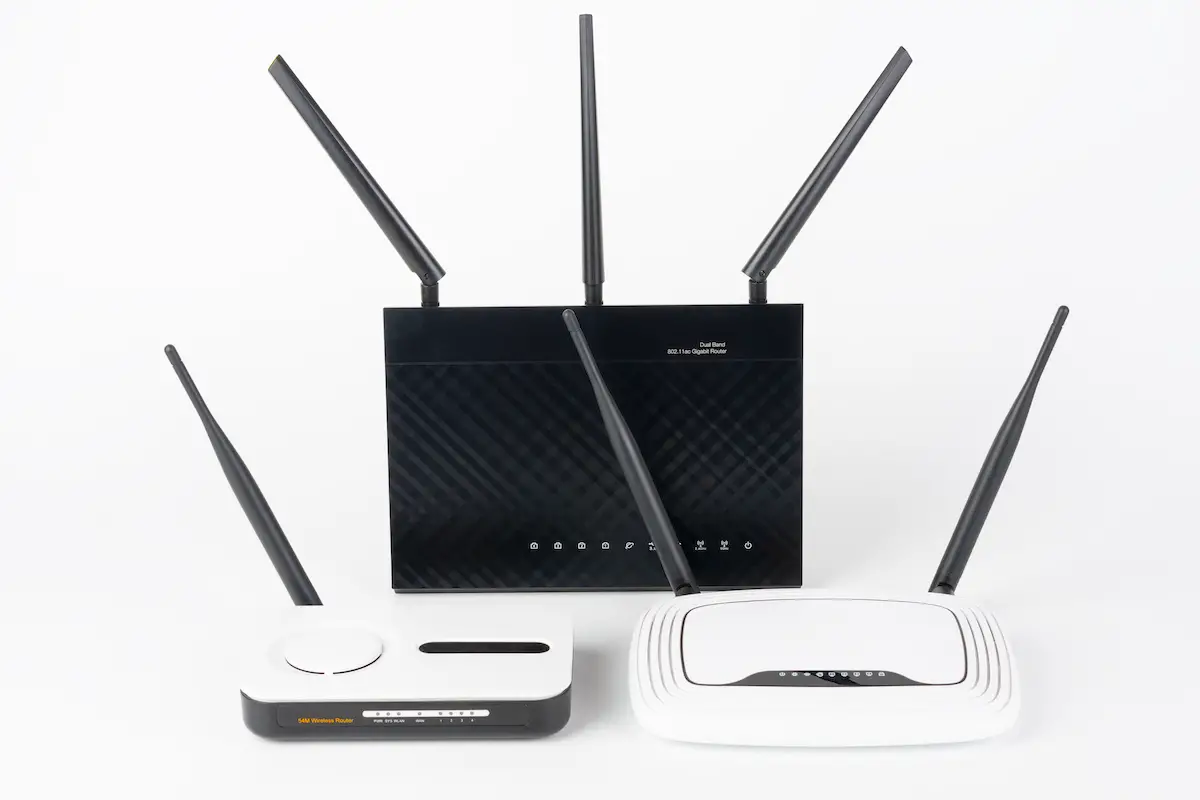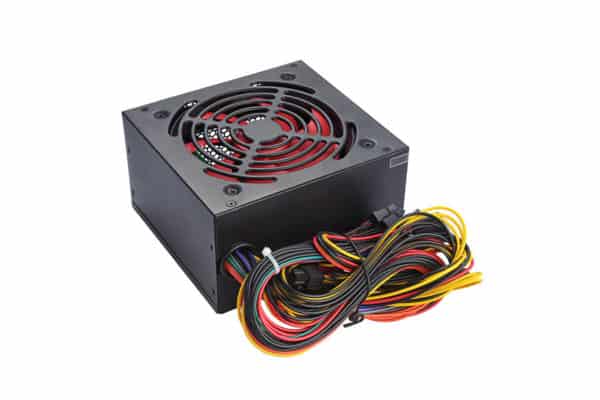Dual-Band vs. Tri-Band – Which Is Best for You?

Estimated reading time: 11 minutes
Table of contents
- Dual-Band Wi-Fi Routers
- How Does a Dual-Band Router Work?
- Features and Capabilities of a Dual-Band Wi-Fi Router
- Dual-Band Router Pros
- Possible Drawbacks
- Tri-Band Routers – The Future-Proof Solution for Power Users
- Tri-Band Router Rating
- Tri-Band Router Pros
- Possible Drawbacks
- Dual-Band vs Tri-Band Routers – Which One Should You Choose?
Between dual-band and tri-band, which Wi-Fi router will facilitate a high-speed connection in every corner of your office or house? Tri-Band routers are an upgrade from dual-band routers. Even so, this choice is not as straightforward as it may seem.
Both router options offer multiple frequency bands. As such, these devices connect to your wireless devices and push data through different radio streams. This, in turn, increases the bandwidth while allowing you to connect more devices to the network.
Dual-band and tri-band routers, regardless of the model, have different capabilities and features. This makes them suited for different applications. To make the right choice, you need to understand the benefits and the situations that each of the router types is designed for.
Dual-Band Wi-Fi Routers
Dual-band routers offer two different frequency channels. In addition to a 2.4 GHz Wireless-N standard frequency band, these devices offer a 5 GHz band. Theoretically speaking, the two bands can support speeds of about 2,167 Mbps.
In most dual-channel router models, the 2.4GHz channel uses the older 802.11n Wi-Fi technology. As such, this channel is backward-compatible with older devices. You may find this channel to be slow and congested from time to time. This is particularly the case if most of your wireless devices are designed to use this Wi-Fi frequency band.
The second channel on these routers works on the newer 802.11ac Wi-Fi standard and broadcasts a 5GHz spectrum. You will find this channel to be faster and less congested than the first one. So, how exactly does this work?
How Does a Dual-Band Router Work?
A dual-band router broadcasts two different signals at the same time—a 2.4GHz signal and a 5GHz signal. If you have modern wireless devices that support a 5GHz Wi-Fi connection, they will automatically connect to this spectrum. Your older wireless devices will automatically connect to the 2.4 GHz spectrum.
Think of it as if the dual-band router was hosting two distinct Wi-Fi networks that work on different Wi-Fi standards. With a dual-band route, you will be able to connect 5GHz-compatible devices while still maintaining compatibility for the older 2.4GHz devices.
Most dual-band router models are marketed as “AC1900” products. The AC prefix indicates that the device supports the IEEE 802.11 ac standard. The 1900 part of the name means that the router offers an aggregate bandwidth of 1900 Mbps (up to 600 Mbps for the 2.4 GHz channel and 1300 Mbps for the 5GHz channel).
SEE ALSO: How to Speed Up Wi-Fi at Home
Features and Capabilities of a Dual-Band Wi-Fi Router
Different dual-band router models may be classified into different categories depending on the IEEE standard they use. As such, different models are likely to offer varying features and capabilities, as explained below:
IEEE 802.11 n (Wi-Fi 4) Routers
Older dual-band routers run on the IEEE 802.11n (Wi-Fi 4) standard that was unveiled in 2009. To decongest the 2.4 GHz channel and boost speeds., this protocol added a second channel—the 5 GHz frequency channel.
These routers have a theoretical maximum speed of 300 Mbps, but you can get speeds of up to 450 Mbps when using 3 antennae. Some Wi-Fi 4 routers feature the innovative Multiple Input Multiple Output (MIMO) technology. This means that you can operate multiple receivers/transmitters at one or both ends simultaneously.
The use of MIMO technology on these routers offers a significant increase in data transfer speeds without the need for wider bandwidth. I believe router manufacturers stopped producing these routers, but you can still find some in the market.
IEEE 802.11 ac (Wi-Fi 5)
The IEEE 802.11ac standard is essentially built on the features offered by the IEEE 802.11n standard to improve speed, bandwidth, and throughput. Most of the dual-band routers available today fall into this category. Initially, Wi-Fi 5 routers were meant to offer a single 5GHz frequency band and a range of about 115 ft. (35m).
Even so, you can find dual-band 802.11 ac routers. These offer 2.4 GHz and 5 GHz frequency bands. This ensures backward compatibility with older Wi-Fi b/g/n standards. These routers were produced in two certification phases, namely:
Wave 1
These were the very first of the Wi-Fi 5 routers. They offered a theoretical speed of 1,300 Mbps to 2,300 Mbps. It was the first Wi-Fi standard to ever achieve gigabit speeds—but only theoretically.
Based on findings by Forbes, a Wi-Fi 5 router can only reach speeds of up to 720 Mbps under optimal, real-world conditions. Even so, 802.11ac dual-band routers are 3x faster than 802.11n routers, despite having only three spatial streams.
Wave 2
The IEEE 802.11ac Wave 2 Wi-Fi standard was announced in 2015 by the Wi-Fi Alliance. Wave 2 router hardware offers more throughput and handles multiple connections even better. This standard brought a number of updates that have proven to be helpful in home and office environments.
To enhance the communication process and data transfer speed,, Wave 2 routers support four spatial streams—this was later improved to include support for up to 8 streams.
As opposed to the 64-QAM technology used in Wi-Fi 4 routers, both Wave 1 and Wave 2 Wi-Fi 5 routers use 256-QAM. This alone improved speeds by 20 to 33 percent. The following table shows the main differences between Wave 1 and Wave 2 Wi-Fi routers:
| 802.11ac Feature | Wave 1 | Wave 2 |
| MIMO | SU-MIMO | MU-MIMO |
| Channel Bandwidth | 20, 40, and 80 MHz | 20, 40, 80, 80+80, 160 MHz |
| Beamforming | Explicit Beamforming | Explicit Beamforming |
| No. of Spatial Streams | 3 | 4 |
| QAM | 256-QAM | 256-QAM |
To learn more about the features and capabilities of Wave 1 and Wave 2 routers, check out the “The Fifth Generation of Wi-Fi” white paper by Cisco.
Dual-Band Router Pros
- MU-MIMO technology – this technology allows wave 2 routers to constantly connect to multiple devices at the same time.
- Improved Range and Stability – provided you are using modern hardware, the best dual-band routers will give you better stability and range (as compared to single-band routers).
- Wider Bandwidth – Dual-band routers offer twice the bandwidth you would get with a single-band router.
- Supports more Devices Simultaneously – The 5 GHz band supports modern devices like the iPhone 7, Google Pixel, and PlayStation 4 Pro. The 2.4 GHz channel offers backward compatibility for older devices.
- More Customizable – with two separate frequency bands, the leading dual-band router models allow you to personalize the frequency settings. This will, in turn, give you a certain level of flexibility when setting up the wireless network.
Possible Drawbacks
Regardless of the model, the 5 GHz frequency on dual-band routers has a shorter range as compared to the 2.4 GHz frequency. This is particularly in environments that have multiple obstacles like doors, walls, and furniture.
The 2.4 GHz frequency band has been proven to penetrate such obstacles and travel further. According to Lifewire, the 2.4 GHz frequency band has a range of up to 150 feet indoors and about 300 feet outdoors.
In contrast, the 5GHz band has a range of only 10 to 15 feet depending on the availability of obstacles. As for the WiGig routers, remember that the 60 GHz frequency cannot penetrate walls. This makes them ideal for single-room applications.
Tri-Band Routers – The Future-Proof Solution for Power Users
Tri-band routers broadcast three separate frequency bands. Most of the leading tri-band Wi-Fi router models have a 2.4GHz band and two separate 5GHz bands. Tri-band routers that run on the 802.11ad (WiGig) standard have a 60GHz frequency band instead of the second 5GHz band.
The 2.4GHz frequency band makes these devices backward compatible with older devices. So, why would you need two separate 5GHz channels? The first 5GHz frequency band on a tri-band router is meant to offer fast connectivity with supported (modern) devices.
The other 5GHz band is for overcoming any bottlenecks that may occur on the network, especially when a lot of devices are connected. These devices are designed to sit and share the network across all the connected devices.
For Example:
Suppose you are streaming high-resolution 4K resolution content on a Smart TV that is connected to a router. If the TV was sharing a channel with other wireless devices, such an application can easily “choke up” even the 5GHz channel.
To avoid such a scenario, the router automatically sorts the connected devices. By so doing, it assigns the second 5GHz band to the intensive applications, such as multiplayer games and streaming 4K resolution content. The result is faster and more reliable wireless connectivity.
SEE ALSO: How to Browse Safely on the Internet?
Tri-Band Router Rating
Just as is the case with dual-band routers, tri-band routers are not built equally. For easier identification, manufacturers use the letters AC or AX (for the latest tri-band router models) followed by four digits. You may think of this naming convention as router rating as it specifies its capabilities.
The AC/AX prefix identifies the Wi-Fi standard the router supports. In this case, AC means that the router is running on the IEEE 802.11ac (Wi-Fi 5) standard. AX means that the tri-band router supports the latest 802.11ax (Wi-Fi 6) Wi-Fi standard.
The four-digit number after the prefix indicates the maximum theoretical bandwidth offered by the router. This figure is the aggregate bandwidth offered by all three channels. Here are some of the common tri-band router ratings you should consider:
AC3200
This name means that the router is running on the IEEE 802.11ac and offers an aggregate bandwidth of 3200 Mbps. When broken down, it means that you can get up to 600 Mbps on the 2.4GHz channels, 1300 Mbps on the first 5GHz channel, and 1300 Mbps on the second 5GHz channel.
In other words, it is a Wi-Fi 5 router that offers a maximum data transfer speed of 3200 Mbps—theoretical speed. A good example is the ASUS AC3200 Tri-Band Gigabit Wi-Fi Router.
AC5300
This is also an 802.11ac (Wi-Fi 5) standard but offers an aggregate bandwidth of 5300. If you break this figure down, you will get 1000 Mbps on the 2.4GHz channel and about 2150 Mbps on each of the 5GHz channels. An example of such a router is the Linksys Tri-Band Wi-Fi Router for Home.
Note: Do not let these ratings mislead you as they are only theoretical. Under real-life conditions, the speed will be nowhere near those figures.
Tri-Band Router Pros
- More Bandwidth – with a total of 3 frequency bands, these devices offer much more bandwidth than that offered by the best dual-band router models.
- Reduced Interference and Congestion – all the connected devices are automatically sorted and distributed across the three channels. This reduces congestion and interference on either channel.
- Support for More Devices – the 2.4GHz channel offers backward compatibility for older wireless devices. The two 5GHz connect to the modern supported devices. Automatic allocation allows you to carry out intensive operations on the network without compromising your network speed.
- Quality Processor – the best tri-band router models feature high-quality processors. These allow for seamless and fast transfer of data between devices on your network.
Possible Drawbacks
Although different models are priced differently, tri-band routers are costlier than dual-band routers. Tri-band routers are often marketed as being faster than other router variants, but this is not always the case. Rather, the device allows you to connect to a less congested band within your wireless network.
This, in turn, allows you to connect at the highest speeds offered by your Internet Service Provider (ISP). As a matter of fact, one of the reasons why you may not need a tri-band router.
Dual-Band vs Tri-Band Routers – Which One Should You Choose?
When choosing between dual-band and tri-band routers, speed should not necessarily be your objective. After all, the specified speed a the combined speed for all the bands on the router and not the potential throughput for a device connected to the network.
The real benefit of a tri-band router is its ability to handle multiple devices more efficiently. It does not necessarily increase the throughput beyond 1300Mbps on the 5GHz channel. If you do not have many 5GHz-compatible Wi-Fi devices, a dual-band router will be a perfect choice.
Here are several other things you should consider before making this choice:
Connectivity Needs
How will you be using your Wi-Fi? If you intend to use your home connection for lighter applications, such as video calling, streaming shows, and browsing, then a dual-band router will suffice. Do you have multiple Smart TVs, a home office for remote working, and gaming consoles in your home?
If so, you should go for a tri-band router instead.
Occupancy and Intendend Application
If you live alone in a small apartment or a flat, get a dual-band Wi-Fi router. This is particular because you only need your network to cover a small area. If you happen to be a hardcore gamer who occasionally invites friends for multiplayer gaming, get a tri-band Wi-Fi router instead.
The same goes for a house with multiple occupants. For instance, you may want to stream 4K movies on Netflix while your spouse streams recipe videos. At the same time, you may have a few kids who play video games frequently.
In such a scenario, only a tri-band router can guarantee fast and reliable connectivity at all times.







